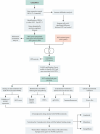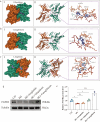FGFR2 identified as a NETs-associated biomarker and therapeutic target in diabetic foot ulcers
- PMID: 40796870
- PMCID: PMC12344841
- DOI: 10.1186/s40001-025-03012-5
FGFR2 identified as a NETs-associated biomarker and therapeutic target in diabetic foot ulcers
Abstract
Background: Diabetic foot ulcer (DFU) is characterized by impaired wound healing and chronic inflammation, partly driven by the excessive formation of neutrophil extracellular traps (NETs). However, the molecular mediators linking NETs to failed tissue regeneration remain poorly understood. This study aimed to identify and validate novel NETs-associated biomarkers in DFU using an integrative bioinformatics and machine learning approach.
Methods: Differentially expressed genes (DEGs) were identified from the GEO dataset GSE134431. These DEGs were intersected with a NETs-related gene set to identify NETs-associated DEGs (NETDEGs). LASSO logistic regression and Random Forest algorithms were applied to the NETDEGs to select key feature genes. The top candidate, Fibroblast Growth Factor Receptor 2 (FGFR2), was validated in two independent datasets (GSE7014 and GSE147890). Its expression was further confirmed in human DFU tissues and diabetic mouse models using qPCR and immunohistochemistry. The effect of a high-glucose environment on FGFR2 expression in neutrophils was assessed in vitro. Finally, molecular docking technique was used to screen for existing drugs targeting FGFR2, with top candidates validated at the cellular level.
Results: Our analysis identified FGFR2 as a key downregulated gene at the intersection of DFU pathology and NETs-related pathways. FGFR2 expression was significantly reduced in DFU tissues across all datasets and in our experimental models, where its downregulation correlated with increased NETs accumulation. FGFR2 demonstrated strong diagnostic potential, with an AUC of 1.00 in the training set. In vitro, high glucose conditions suppressed FGFR2 expression in neutrophils. From 32 glucose-lowering drugs, Canagliflozin and Gliquidone were found to significantly upregulate FGFR2 protein expression in neutrophils, suggesting a potential modulatory effect.
Conclusions: FGFR2 is a promising potential biomarker associated with NET-driven inflammation in DFU. Its downregulation in the diabetic wound microenvironment and its modulation by existing pharmacological agents suggest that targeting the FGFR2 pathway may be a viable future therapeutic strategy for improving DFU healing outcomes. Further preclinical validation is warranted.
Keywords: Bioinformatics; Biomarker; DFU; FGFR2; NETs; Therapeutic Target.
© 2025. The Author(s).
Conflict of interest statement
Declarations. Ethics approval and consent to participate: The study was approved by the Ethics Committee of the Affiliated Central Hospital of Chongqing University with the approval number: 2023 Lun Audit No. (32). All participants gave informed consent. This study was guided by the Animal Welfare Ethics Committee of Chongqing University, and the ethical review number for animal experiments was CQU-IACUC-RE-202401-003. Consent for publication: All authors consent to the publication of this study. Competing interests: The authors declare no competing interests.
Figures








References
MeSH terms
Substances
Grants and funding
- cstc2024ycjh-bgzxm0014/the Natural Science Foundation of Chongqing Municipal Science and Technology Bureau
- 2022KFKT11/the open project of Chongqing Key Laboratory of Emergency Medicine
- 2023KFKT08/the open project of Chongqing Key Laboratory of Emergency Medicine
- 82370903/the National Nature Science Foundation of China
- 2023ZD0509400 & 2023ZD0509402/Noncommunicable Chronic Diseases-National Science and Technology Major Project
LinkOut - more resources
Full Text Sources
Medical
Miscellaneous

